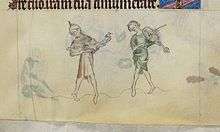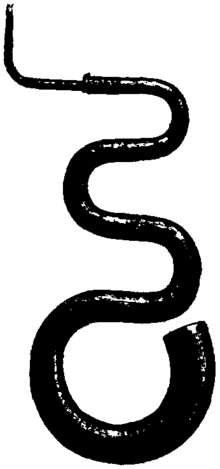Rebec
|
The rebec in "Virgin among Virgins" (1509), by Gerard David. | |
| String instrument | |
|---|---|
| Classification | |
| Hornbostel–Sachs classification |
321.21-71 (Bowl lyre sounded by a bow) |
| Developed | Middle Ages |
| Related instruments | |
The rebec (sometimes rebecha, rebeckha, and other spellings, pronounced /ˈriːbɛk/ or /ˈrɛbɛk/) is a bowed stringed instrument of the Medieval era and Renaissance era. In its most common form, it has a narrow boat-shaped body and 1-5 strings. Played on the arm or under the chin, the technique and tuning may have influenced the development of the violin and the extended technique of bowed banjo.
Origins

Popular from the 13th to 16th centuries, the introduction of the rebec into Western Europe coincided with the Arabic conquest of the Iberian Peninsula. There is however evidence of the existence of bowed instruments in the 9th century in Eastern Europe. The Persian geographer of the 9th century Ibn Khurradadhbih cited the bowed Byzantine lira (or lūrā) as typical bowed instrument of the Byzantines and equivalent to the Arab rebab.[1][2][3][4]
The rebec was adopted as a key instrument in Arab classical music and in Morocco a tradition of Arabo-Andalusian music has been kept alive by descendants of Muslims who left Spain as refugees following the Reconquista. The rebec became a favourite instrument in the tea houses of the Ottoman Empire.
The rebec was first referred to by that name around the beginning of the 14th century, though a similar instrument, usually called a lira da braccio (arm lyre), had been played since around the 9th century.[5] The name derives from the 15th century Middle French rebec, altered in an unexplained manner from the 13th century Old French ribabe, which in turn comes from the Arabic rebab.[6]
A distinguishing feature of the rebec is that the bowl (or body) of the instrument is carved from a solid piece of wood. This distinguishes it from the later period vielles and gambas known in the Renaissance.
Tuning
The number of strings on the rebec varies from 1 to 5, although three is the most common number. The strings are often tuned in fifths, although this tuning is not universal. The instrument was originally in the treble range, like the violin, but later larger versions were developed, so that by the 16th century composers were able to write pieces for consorts of rebecs, just as they did for consorts of viols.
In use
In time, the viol came to replace the rebec, and the instrument was little used beyond the renaissance period. The instrument was used by dance masters until the 18th century, however, often being used for the same purpose as the kit, a small pocket-sized violin. The rebec also remained in use in folk music, especially in eastern Europe and Spain. Andalusi nubah, a genre of music from North Africa, often includes the rebec.
Artists
- The original Michael Nyman Band included a rebec before the band switched to a fully amplified lineup.
- Les Cousins Branchaud, a folk music group from Quebec, Canada, includes a rebec player.
- Ensemble Micrologus, an Italian medieval music group, has a member who performs on rebec.
- Tina Chancey is a multi-instrumentalist specializing in early bowed strings like the rebec. She also plays in Hesperus, an early music and folk music group.
- Dominique Regef is a French musician, composer and improvisor who performs on, among other instruments, the rebec.
- Giles Lewin, while being more famous for his work on violin and bagpipes, also plays the rebec in the Dufay Collective.
- Rossen Genkov is a rebec virtuoso. He appeared onstage with the Bulgarian band Epizod.
- Sisters Shirley and Dolly Collins have released a number of albums that include the rebec.
- Oni Wytars, a European music group, often includes the rebec in their performances.
- Helen Johnson plays the rebec, and its close relative the violetta, in the British early music group Cancionero.
- Siba de Oliveira Veloso, from Mestre Ambrósio and Siba e a Fuloresta, and Antônio Nóbrega plays the rebec in a very Brazilian folcloric way, which has a large number of players in its north-east part.
- Swedish progressive rock band Älgarnas Trädgård list rebec as an instrument used on their 1972 album 'FRAMTIDEN ÄR ETT SVÄVANDE SKEPP, FÖRANKRAT I FORNTIDEN'
The rebec in popular culture
Hugh Rebeck is a minor character in William Shakespeare's Romeo and Juliet, one of the musicians called by Peter in an oft-cut scene. Presumably, he is named for the instrument that he plays.
In a scene in Don Quixote, a goatherd entertains Don Quixote and Sancho Panza by playing a rebeck and singing a love song.
A rebec featured prominently in one of Ellis Peters' (12th century) Brother Cadfael stories: Liliwin, the title character of The Sanctuary Sparrow, earned his living by playing that instrument. His rebec was damaged by a mob that accused him of murder, but one of the monks repaired it and returned to him at the end of the story.
See also
- Rabeca
- Byzantine lyra: the pear-shaped bowed stringed instrument of the Byzantine Empire.
- Calabrian lira
- Cretan lyra: The pear-shaped bowed instrument of Crete, Greece.
- Dramyin: a Himalayan folk music instrument.
- Gadulka: a Bulgarian stringed instrument.
- Gusle: a Serbian folk instrument
- Kamencheh: a four-stringed instrument similar to the kemenche.
- Kemenche: a three-stringed instrument from the Black Sea region of Asia Minor.
- Lijerica Croatian or Dalmatian instrument
- Rabel: a Spanish folk instrument
References
- ↑ Margaret J. Kartomi, 1990
- ↑ Farmer, Henry George (1988), Historical facts for the Arabian Musical Influence, Ayer Publishing, p. 137, ISBN 0-405-08496-X
- ↑ For a possible etymological link between Arabic rebab and French rebec see American Heritage Dictionary
- ↑ Panum, Hortense (1939), The stringed instruments of the Middle Ages, their evolution and development, London : William Reeves, p. 434
- ↑ Bachmann, Werner (1969). The origins of bowing and the development of bowed instruments up to the thirteenth century. Oxford University Press. p. 35.
- ↑ Harper, Douglas. "rebec (n.)". Online Etymology Dictionary. Retrieved 5 October 2015.
External links
- The Rebec – Short history of the rebec, and sound sample.
- The Rebirth of the Rabeca Fiddle of Brazil
- The Rebec Page – Origins, morphology, construction, and sound sample.
- Tenor rebec photo
 Chisholm, Hugh, ed. (1911). "Rebec". Encyclopædia Britannica (11th ed.). Cambridge University Press.
Chisholm, Hugh, ed. (1911). "Rebec". Encyclopædia Britannica (11th ed.). Cambridge University Press.

